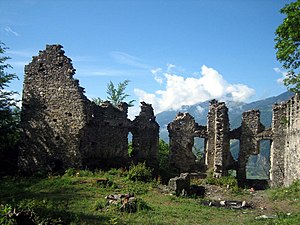Wynegg Castle
| Wynegg Castle | ||
|---|---|---|
| Creation time : | around 1200 | |
| Castle type : | Höhenburg, spur location | |
| Conservation status: | ruin | |
| Construction: | Quarry stone | |
| Place: | Malans | |
| Geographical location | 46 ° 59 ′ 40 " N , 9 ° 34 ′ 12" E | |
|
|
||
The castle Wynegg is a high medieval castle ruins northeast of the municipality of Malans in the Swiss canton of Grisons.
location
The ruins are located above Malans on a rock spur in the forest and can be easily reached on foot from the village in around twenty minutes. Access by car is not possible.
investment
The remaining wall remains on the valley side extend to the first floor and are broken through by various window openings. Holes in the bars reveal the division of the floors. The fortified palace in the northeast and the two-part courtyard, which was protected by a 2.4 meter thick wall against the neck ditch , were part of the defense structure . The hall was originally three-story, the walls reached a thickness of up to 2.6 meters below. The main living room was on the second floor. At the north corner was the 2.6 meter wide gate that could be locked with a locking bar. The walls were erected without great care, as the humpback cubes and the ears of corn that were common for this time are missing . The 2.5 meter thick surrounding wall on the mountain side goes back to the original building stock, the appearance of which is poorly informed due to the renovations.
During the feudal period, Wynegg was in visual contact with numerous other castles such as Neu-Aspermont , Maienfeld , Sargans , Ober-Ruchenberg and Freudenberg .
history
Wynegg Castle was the center of a small lordship and was probably founded by a local noble family in the early 13th century. This first appears in the documents in 1254 with the knight Ludwig von Wynegg, but according to Ulrich von Wynegg (1266–1270) it disappears again from the sources around 1273 with the clergyman Ludwig. They were witnesses in legal transactions of the Chur bishop and Walther IV., Baron von Vaz .
After the Lords of Wynegg died out, the castle and the lordship came to the Vaz family, although the Chur bishop asserted his feudal sovereignty over Wynegg. Johann von Vaz seems to have recognized this at first, but later denied it. After an arbitration award from 1299 he should prove that Wynegg was his rightful fiefdom: ... that he was right to the same bvrg ze Winegge .
Even after the Vazer became extinct in 1337/38, ownership remained initially unclear. On December 6th, 1338 Ulrich von Montfort had to give the castle Wynegg back to his uncle, Count Friedrich V von Toggenburg , ... the castle Wineg inantvurden and immediately against ..... return. He had inherited it rightfully, as he was married to Kunigunde von Vaz. Five days later, Friedrich and Kunigunde received the Burg Winegge from the bishop as a fief .
In the following decades the Toggenburger Wynegg held together with the Schanfigg and Davos as Chur hereditary marshals as a fief. When the Toggenburgs once rejected the episcopal claim to Wynegg, a war broke out between the bishop and the count, in which the Toggenburgers even besieged Chur. The castle was evidently briefly withdrawn from Friedrich VII , but after an arbitration ruling by the city of Zurich in 1421 it was returned. It was decided, "Count Friedrich has to recognize Wynegg Castle and the Schanfigg as a fiefdom of the bishop ... and to take the fief-oath within a year, otherwise he will lose the fief".
After the death of this last Toggenburg resident on April 30, 1436, the bishop initially took the castle as a fallen fiefdom . On April 7, 1441, Bishop Conrad von Rechberg and on April 17, 1446 Bishop Heinrich von Hewen enfeoffed the Junker Heinrich Amsler with Wynegg and interest from the Domleschg. As Vogt von Zizers, Chur and captain in Vintschgau, Amsler played an important role in the episcopal administration.
Towards the end of the 15th century the castle was abandoned and began to crumble. At the turn of the 16th to the 17th century, when most of the other Rhaetian castles had long been in ruins, Andreas von Salis built a new building on the ruins of the old complex. The old walls were removed up to the level of the first floor and a building in the form of an urban patrician house with three floors and walls only 70 cm thick was built above it. The paneled living rooms were on the second and third floors, which also housed the kitchen. The cellars were vaulted with barrels.
Von Salis' daughter Margaretha brought the residence to the Guler von Davos family through marriage, who restored Wynegg and called themselves Guler von Wynegg around 1624. In the description of a chronicler from 1744, the former castle is still described as "a jolly Schlösslin, belonging to Messrs Guler at Jenins", which was "in its essence close to home and habitable". Towards the end of the 18th century, however, Wynegg was finally abandoned and left to decay. In 1793 the castle and its accessories came to the Malans community for 2200 guilders , which is still the owner of the ruins today.
literature
- Fritz Hauswirth: Castles and palaces in Switzerland . Volume 8. Neptun Verlag, Kreuzlingen 1972.
- Otto P. Clavadetscher, Werner Meyer : The castle book of Graubünden . Orell Füssli, Zurich 1984, ISBN 3-280-01319-4 .
- Werner Meyer: Castles of Switzerland . Volume 3. Silva Verlag, Zurich 1983.
- Anton von Castelmur: The castles and palaces of the Canton of Graubünden. Volume I, Birkhäuser Verlag, Basel 1940
Web links
- Castle world: Wynegg Castle
- Maria-Letizia Boscardin: Wynegg. In: Historical Lexicon of Switzerland .







